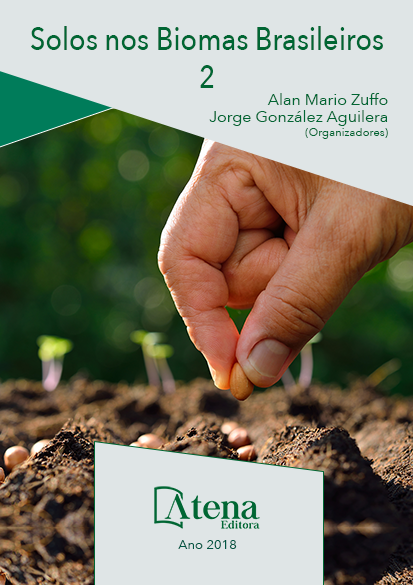
ÍNDICE DE EFICIÊNCIA AGRONÔMICA DE TERMOFOSFATOS EM SOLOS COM DIFERENTES CONCENTRAÇÕES INICIAIS DE FÓSFORO
A fertilização fosfatada nos solos
tropicais possui eficiência muito variável,
dependendo, dentre outros fatores, da fonte
de P utilizada, das propriedades do solo e da
espécie e variedade vegetal cultivada. Dentro
desse contexto, objetivou-se avaliar a eficiência
agronômica de termofosfatos, em solos com
concentrações iniciais de P distintas, utilizandose o milheto (Pennisetum glaucum (L.) R.
Br.) como planta indicadora. Foi utilizado um
Nitossolo da Fazenda Experimental Lageado,
coletado em área de produção agrícola, com
médio teor de P. Adjacente à área de produção,
em mata natural, coletou-se o mesmo solo, com
baixo teor de P. Em casa de vegetação elaborouse um experimento com quatro fertilizantes
fosfatados: termofosfato magnesiano (TM),
termofosfato potássico (TK), termofosfato
grosso (TG), e superfosfato triplo (ST) como
referência. As plantas foram avaliadas quanto a
massa de matéria seca e teor de P para cálculo
do Índice de Eficiência Agronômica – IEA. O
termofosfato com granulometria grosseira tem
sua eficiência altamente prejudicada em razão
de sua menor solubilidade. Os termofosfatos
possuem eficiências agronômicas distintas em
função da concentração inicial de P no solo,
eles são mais eficientes quando esse nível é
previamente adequado. O índice de eficiência
agronômica dos termofosfatos TM e TK é inferior
ao padrão num solo com baixo teor inicial de P,
e superior ao padrão num solo com adequado
teor inicial de P.
ÍNDICE DE EFICIÊNCIA AGRONÔMICA DE TERMOFOSFATOS EM SOLOS COM DIFERENTES CONCENTRAÇÕES INICIAIS DE FÓSFORO
-
DOI: 10.22533/at.ed.09418141213
-
Palavras-chave: Termofosfatos. Eficiência agronômica. Diferentes concentrações iniciais de fósforo. Adubação fosfatada.
-
Keywords: Thermophosphates. Agronomic efficiency. Different phosphorus initial concentrations. Phosphate fertilization.
-
Abstract:
Phosphate fertilization on tropical
soils has very variable efficiency, depending,
among others factors, from the P source used,
the soil properties and the vegetal specie
and variety cultivated. Inside this context, the
objective of this experiment was to evaluate the
thermophosphates agronomic efficiency, in soils
with different phosphorus initial concentration,
using millet (Pennisetum glaucum (L.) R. Br.)
as indicator plant. It was used a Nitosol from
the Experimental Farm Lageado, collected in
an agricultural production area, with medium
concentration of P. Adjacent to the production
area, in an natural forest, the same soil was
collected, with low P concentration. The
experiment was elaborated in a greenhouse
with four phosphate fertilizers (magnesium thermophosphate (TM), potassium thermophosphate (TK), coarse thermophosphate
(TG), and triple superphosphate (ST) as reference). At the end of the experiment the
soil chemical composition (P, K, Ca, Mg and Si content) was evaluated. The plants
were evaluated for dry matter mass and P content to calculate the Agronomic Efficiency
Index – IEA. The thermophosphate with coarse granulometry has its efficiency highly
impaired due its lower solubility. The thermophosphates have different agronomic
efficiencies, depending of the initial concentration of P in the soil, they are more efficient
when this level is previously adequate. The agronomic efficiency index of TM and TK
thermophosphates is lower than the standard fertilizer in a soil with a low initial P
content, and higher than the standard in soil with an adequate initial P content.
-
Número de páginas: 15
- Juliana de Lima Moretto


